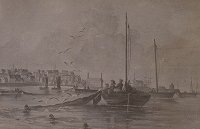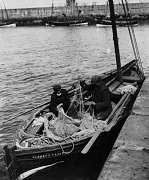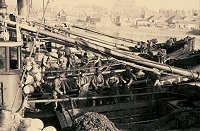Herring Home | Fishing for herring | Next
The Nets

Most herring was caught using drift nets. Although we do not know for certain, they have probably been in use for thousands of years. Until the mid 20th century, the technology remained largely unchanged from the Dutch herring fishing of the 16th century and even earlier. Drift nets are so called because the boat drifts with the tide allowing the nets to become fully stretched. The boats were named drifters after their nets.

Fishermen sailed to where they thought they would find herring, or until they saw signs of the fish in the water. Nets were put out or shot at dusk when the herring were feeding close to the surface. The herring boat was swung round to face the wind and was left to drift, usually for most of the night. As she drifted she pulled on the long warp rope so keeping her nets taut. When fish swim into the nets, the mesh allows an adult herring to enter as far as its head but when it tries to wriggle backwards, the threads of the mesh catch under its gills stopping it from moving.
The drift
The drift is a string, or train of joined nets, also sometimes known as a fleet. These joined nets hang like a long curtain extending across the sea and provide a perforated wall in the water. Originally the nets were simply tied together end to end but as longer net trains developed a connecting rope or back rope was used. Through time, as boats increased in size, the number of nets in the drift increased. The train of nets was attached to the bow of the boat by a long swing rope.

The tops of the nets sit just below the surface and are kept afloat by cork pieces threaded along the length. At greater intervals (usually at the joins between the nets), large floating buoys mark the top edge of the drift. In the early 19th century, buoys were made from the inflated bladders of pigs or bullocks, or from the skins of dogs or sheep. More recently buoys were made from canvas, and they are now mainly plastic or aluminium.
A tarred warp rope, also known as a messenger rope was the backbone of whole train. Hemp nets were used until the middle of the 19th century. These heavy nets were suspended below the warp and their own weight held them down in the water. In the 1860s lighter cotton nets were introduced. There was less weight to keep these nets down so the position of the warp was changed to the lower edge of the nets. The heavy warp weighed down the nets to keep them vertical. The lower edge of the nets were either left to float free or were rigged at intervals with loops for attaching stone weights. Weights to hold down the bottom of the net are known as sinkers and more recently were made from lead.
Find out more about making and maintaining the nets.